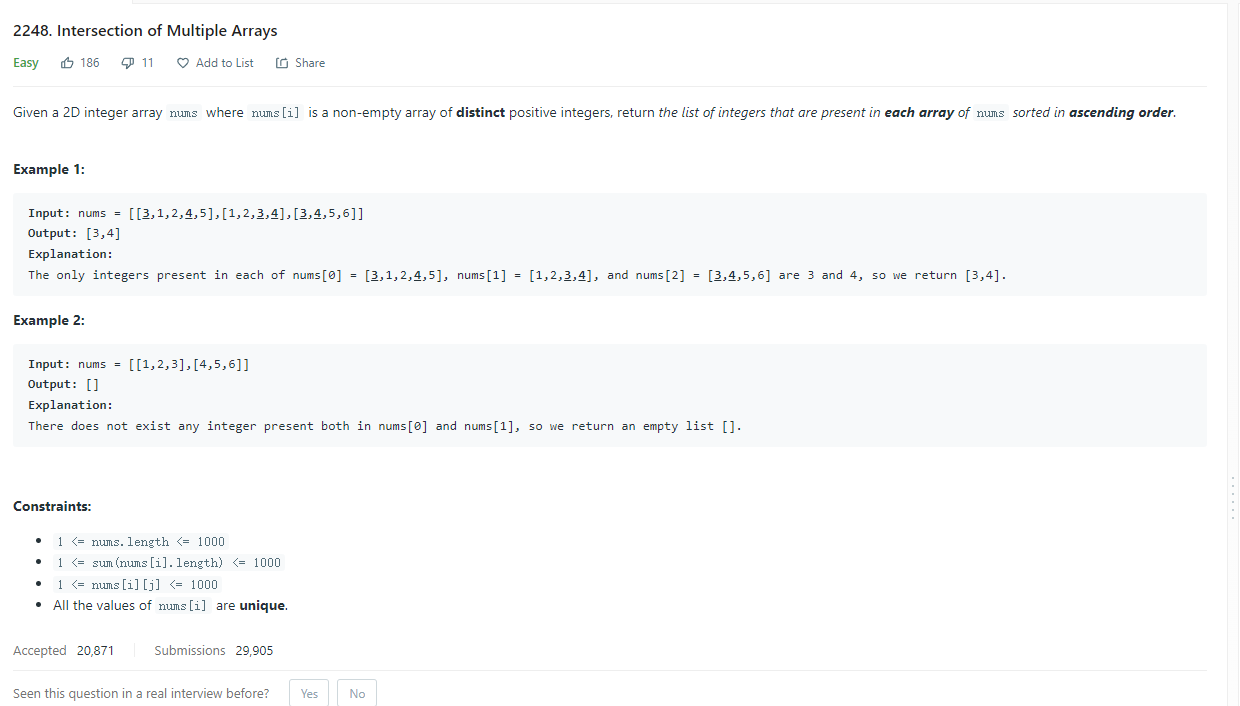题目 https://leetcode.com/problems/intersection-of-multiple-arrays/
思路 这道题我第一反应是用动态解析,不断地比对交集并且进行记录。但是马上我意识到我可能把这道题想得复杂了一些。从结果来思考,结果必然同时存在于所有的数组中,那么我们只需要用第一个数组和后续数组进行交集比对,把相交结果存在一个新的数组中,用这个新数组来继续和后续数组进行交集比对,比对一轮之后剩下的就是结果。
1 2 3 4 5 6 7 8 9 10 class Solution(object): def intersection(self, nums): """ :type nums: List[List[int]] :rtype: List[int] """ result = set(nums[0]) for num in nums: result= result & set(num) return sorted(list(result))
同时根据Discuss中的答案上,有说使用C++的map函数来做的,我看了看map的用法,应该是通过循环遍历map,value值和arr.size()相等则意味着它在每个数组中都出现过,即是我们需要的交集。
1 2 3 4 5 6 7 8 9 10 11 12 13 14 15 16 class Solution { public: vector<int> intersection(vector<vector<int>>& nums) { map<int, int> ump; for(int i = 0; i < nums.size(); ++i) for(int j = 0; j < nums[i].size(); ++j) ump[nums[i][j]]++; vector<int> res; for(auto it = ump.begin(); it != ump.end(); ++it) if(it->second == nums.size()) res.push_back(it->first); return res; } }; // In here we cannot use unordered_map, otherwise we will need to sort res
另外好像存在第三种,递归的算法,我没看明白和set的区别。https://leetcode.cn/problems/intersection-of-multiple-arrays/solution/by-nehzil-9383/
还有一个两行的算法,我看这种又短又复杂的会头晕….
1 2 3 class Solution: def intersection(self, nums: List[List[int]]) -> List[int]: return sorted(reduce(set.__iand__, map(set, nums)))
2022/5/28更新
我最近在看CMU 213这门课,发现原来这道题可以直接用位运算的&运算符来做,但是在discuss中的C++. Fast. Low memory. Bitset based solution. 我不太看得明白,代码如下:
1 2 3 4 5 6 7 8 9 10 11 12 13 14 15 16 17 18 19 20 21 22 23 24 class Solution { public: vector<int> intersection(vector<vector<int>>& nums) { static_assert(sizeof(unsigned long) == 8); uint64_t acc[16], buf[16]; memset(acc, -1, sizeof(acc)); for (auto &arr : nums) { memset(buf, 0, sizeof(buf)); for (int v : arr) { buf[v >> 6] |= 1llu << (v & 0x3f); } for (int i=0; i < 16; i++) acc[i] &= buf[i]; } vector<int> ans; for (int i=0, v=0; i < 16; i++, v=i<<6) { uint64_t b = acc[i]; while (b) { ans.push_back(v + __builtin_ctzl(b)); b ^= b & -b; } } return ans; } };
